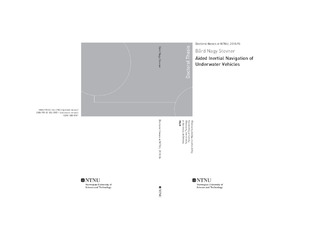| dc.description.abstract | This thesis is motivated by cost reduction in subsea inspection, maintenance, and repair operations, which requires autonomy and automatic functionality in order to save time and money. Autonomy and automatic functions means taking some aspects of the intervention out of the hands of the human operator, and letting the underwater vehicle make some decisions and perform some actions independently. A prerequisite for the underwater vehicle making a decision and performing an action independently is reliable information about the current state of the vehicle, i.e. its position and attitude. This thesis focuses on reliable and high performance estimation of position and attitude of an underwater vehicle using measurements from inertial measurement units and hydroacoustic sensor networks. The high performance is ensured by using linearized Kalman filters, an industry standard for that purpose. The reliability is ensured by mathematical proofs of the guaranteed convergence of the estimates to the true value regardless of how erroneous the initial estimate is.
The main part of this thesis presents four estimation concepts, for some of which multiple estimators are developed. The first is an attitude estimator based on inertial measurement unit and magnetometer measurements. This estimation problem has attracted significant attention in last 50 years, and a multitude of solutions has been proposed. The estimator developed in this thesis is the first Kalman filter based solution with a minimal state error representation and proven global exponential stability. The proposed estimator is compared with existing solutions both in simulations and using experimental data.
The second is position estimation based on inertial measurement unit, hydroacoustic long baseline, and pressure sensor measurements. Hydroacoustic range measurements are found by multiplying the travel time of a signal with the wave speed, i.e. speed of sound in water. Since the wave speed vary with the water conditions and therefore is not accurately known, the proposed estimators estimate it as well.
The third estimation concept is position estimation based on measurements from an inertial measurement unit, a pressure sensor, and a hydroacoustic sensor network called inverted short baseline. The inverted short baseline network consist of multiple hydroacoustic sensors on the vehicle, and it is shown that only one hydroacoustic transponder is then needed on the sea floor. This lowers the requirement for external infrastructure, which in turn lowers deployment and maintenance costs. Several estimators are developed and analyzed, and a comparison study using both simulated and experimental data is conducted.
The fourth estimation concept uses the inverted short baseline network described above for both position and attitude estimation. The motivating scenario is that the magnetometer measurements become corrupted by the magnetic fields produced e.g. by the vehicle’s motors or a subsea facility. It is shown that the inverted short baseline network along with two transponders on the sea floor can replace the need for magnetometer measurements, thereby providing redundancy.
All of the solutions to the above estimation concepts attain global exponential stability through a mathematical stability analysis and are based on the linearized Kalman filter ensuring high performance. | nb_NO |
